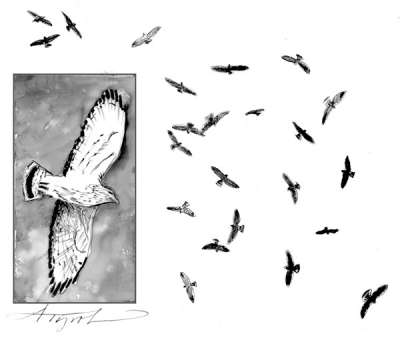
It rained heavily the first time I had planned to go on a hawk watch, and the trip to Mt. Tom in western Massachusetts was cancelled. But the rain brought with it a weather front the next day that created the perfect conditions for fall hawk migration in New England. And migrate they did. Hawks and falcons and eagles and vultures soared southward along mountain ridges in numbers I have never seen in the 30 years since then. Carried aloft by rising currents of warm air and light winds from the north, many of those birds may have traveled a hundred miles that day without ever flapping their wings.
Despite the diversity and impressive numbers of raptors, there was one species that stood out to all of the hawk watchers: the broad-winged hawk. It was a bird I had never seen before, and although it is a common nesting species in the forests of the Northeast, the total number of broad-wings I’ve observed since then doesn’t come close to the number that soared past Mt. Tom that day. Whereas most hawks travel alone or in groups of three or four, broad-winged hawks migrate in flocks called kettles that can sometimes number in the thousands.
But they aren’t easy to see. They are the smallest of the soaring hawks in our region, and while their deep, rounded wings and banded tail are distinctive field marks when flying just above the treetops, they are tiny speck-birds high in the sky during migration. Most of the time the broad-wings I watched weren’t detectable unless I slowly scanned the sky with my binoculars, and even then they were easy to miss.
Occasionally, though, I noticed what resembled a swarm of no-see-ums. Circling together ever higher, the hawks eventually reached an elevation where the warm updraft had cooled enough that they couldn’t rise any higher, and one by one they shot from the top of the kettle in a straight line south and down until they found another current of warm air to carry them up again. That behavior made it easy to count the hawks, and that first kettle totaled more than 400 birds. We saw seven more kettles soar by the mountain that day, and all had more birds than that first one.
Broad-winged hawks from throughout eastern North America migrate to South America each fall, and their migration takes them through the narrow parts of Central America where they crowd into what has been described as “a river of raptors” in Veracruz, Mexico and across Panama. Once on their wintering grounds, they travel very little; each bird spends most of the next five months within an area of about one-square mile.
In the Northeast, on their breeding grounds, they live in deciduous and mixed forests, usually far from areas of human disturbance. They hunt for small mammals and amphibians from perches beneath the canopy in the forest interior, making them inconspicuous most of the time. Apart from fall migration, they are most often seen in late spring as they soar above the tree canopy in defense of their territory or when performing their courtship display flight, which involves circling high in the air and then plummeting toward the ground. The breeding pair builds a nest of sticks lined with fresh plants, typically in the first crotch of a tree, where the female lays two to five eggs and incubates them for about a month. By the time the young are fledged and have learned to hunt, it’s about time for their first migration. In our region, this occurs primarily in September.
That’s also the time that I return to various hawk watching sites each year, hoping to catch the spectacle of broad-winged hawks flying south. But I have never been able to match my first experience. The birds still fly south in large kettles when the weather conditions are right, but on those days I apparently have other commitments or I’m just not paying close enough attention to the forecast.
If you’d like to try your luck, wait for the passage of a low pressure weather system or an advancing cold front from the north that will carry the birds southward. Pick the right day, and you’ll likely enjoy the sight of hundreds of broad-winged hawks and other raptors sailing toward their winter homes.


Discussion *